One of the first projects I undertook at Glen Villa was the China Terrace, a contemporary folly that honours an old resort hotel that once stood on the property.
I first wrote about it as a conceptual garden. Following that, I wrote about it sporadically, focusing on the changes I made — the bed that shook off its annuals in favour of a moss quilt,
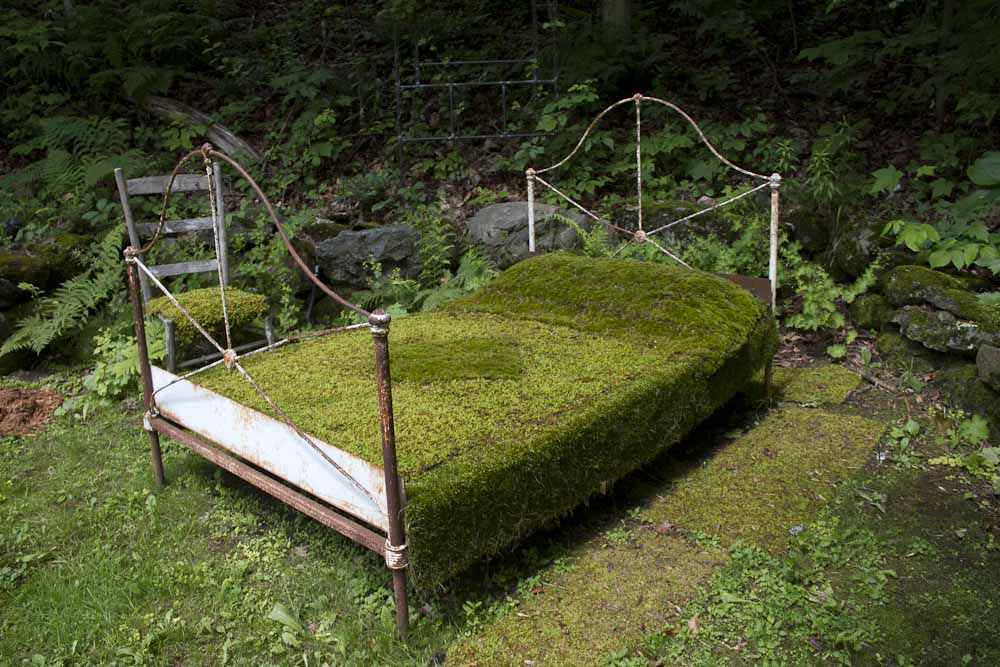
Moss forms a quilt on an old iron frame bed.
and the staircase leading to the imaginary second and third story that changed, from this …
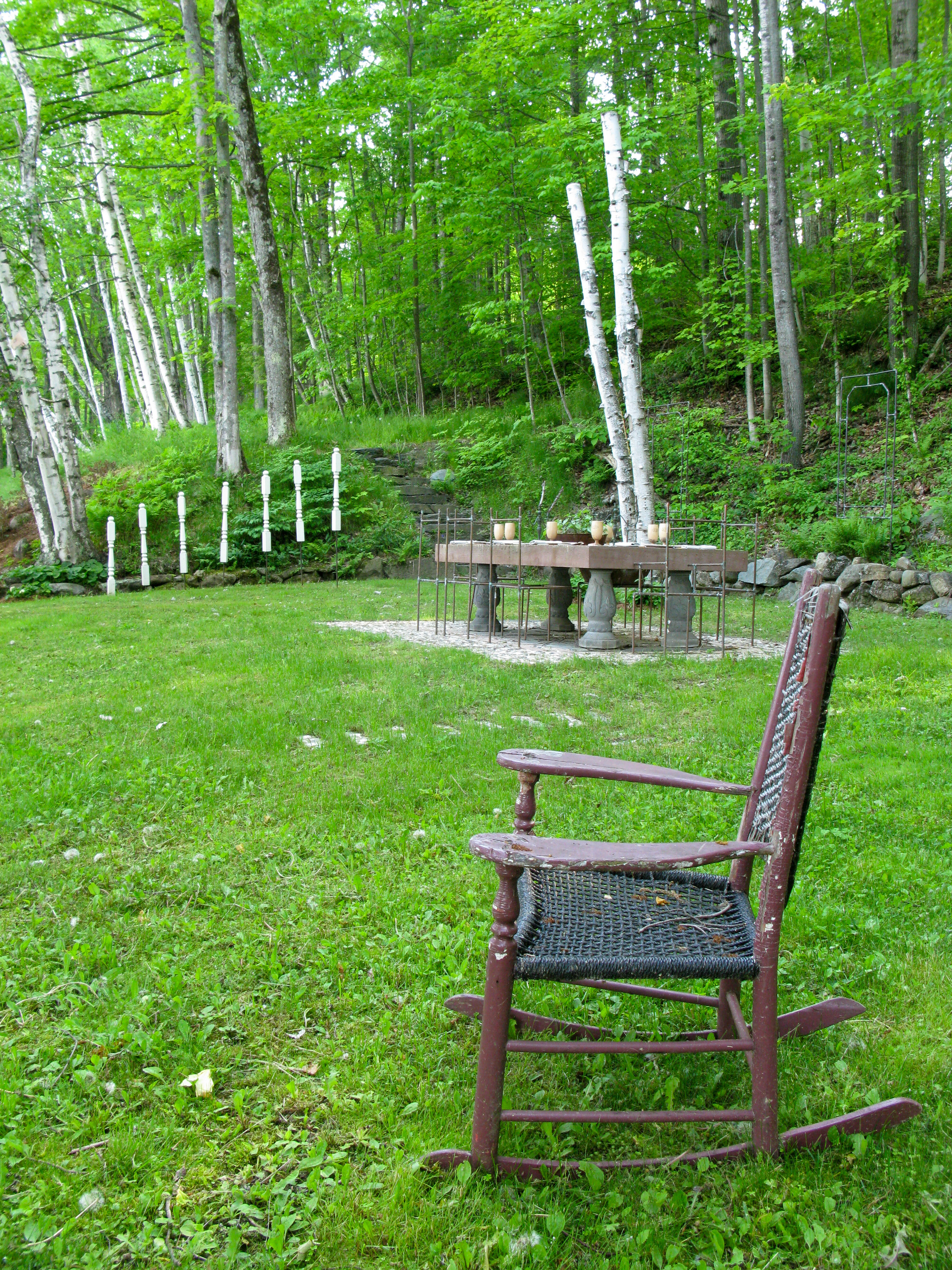
This version of the staircase dates from 2009. It’s hard to tell from the photo but the posts curved slightly, to suggest a circular staircase.
to this …
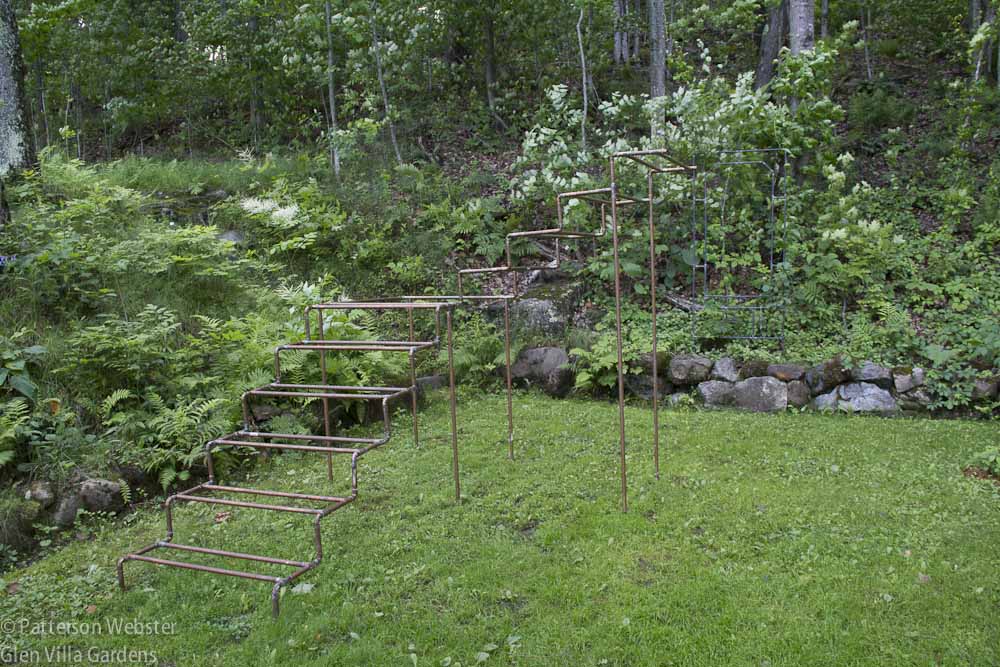
Copper tubing outlining the ‘staircase’ that led to an upper floor didn’t have enough weight visually.
to this …

Combining wood and copper tubing linked the staircase to the window frames on the China Terrace. While it may look ok in the photo, I found this version too heavy visually.
… and, finally, to this.
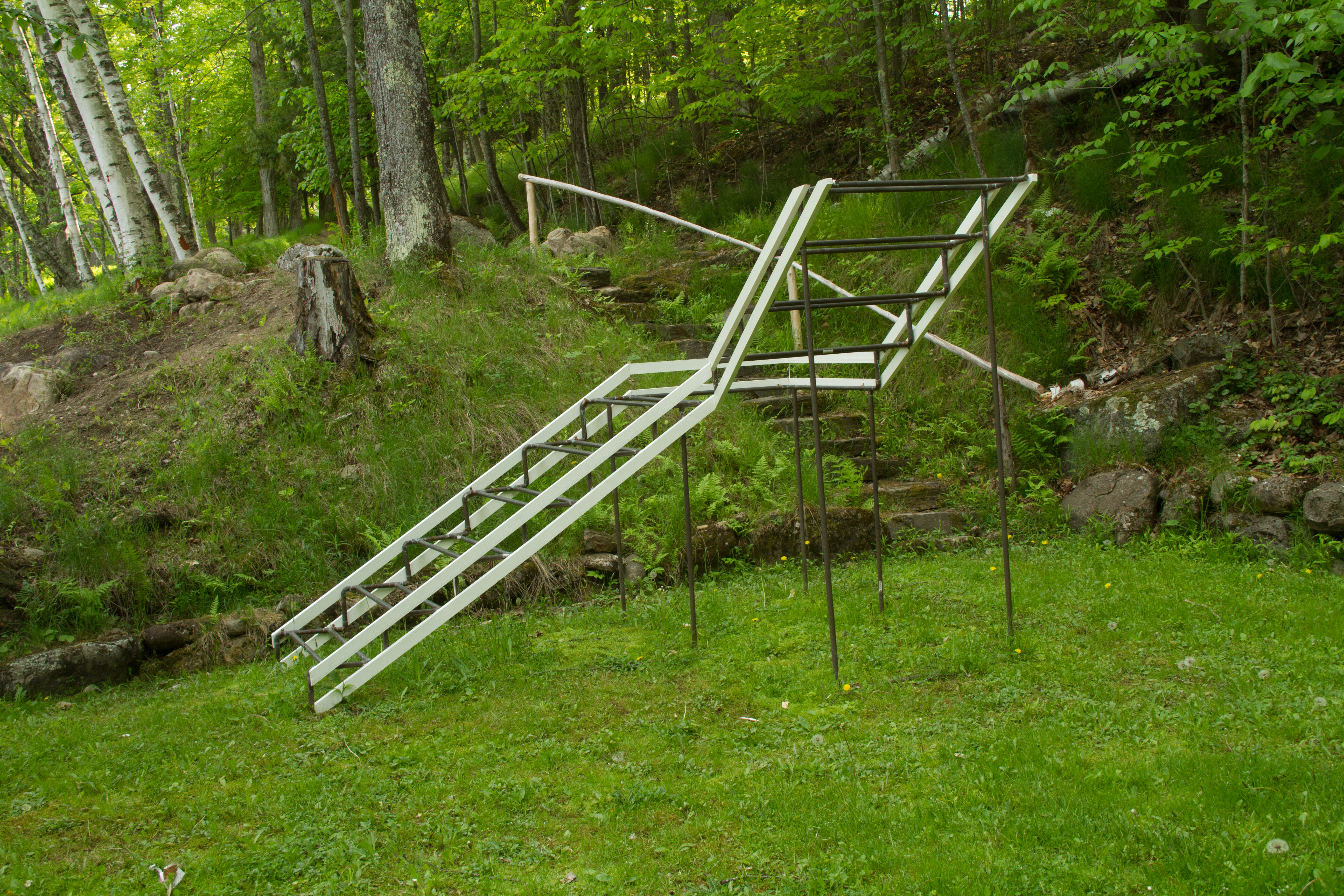
Using two narrow strips along the sides rather than a single wide one lightens the appearance of the staircase while outlining its form.
These tweaks were necessary but relatively minor, and didn’t get at the main problem — the plants. There were two areas that bothered me, one on the bank (shown behind the staircase in the photo above) and the other beside the entry. I identified the problem at the end of 2013.
“This area and the entry bed it is part of simply don’t work as they should, which is to announce the presence of a ghostly recreation of a Victorian era hotel. Plus the deer like too many of the plants …. Plus [I need] more terracing and a re-shaping of the edges. “
Over the last five years I’ve tried to correct the problems in various ways. I thought about fencing the whole terrace but discarded the idea — to do it the way I wanted to would have cost a fortune. So I took smaller steps. I enriched the soil, added rocks to stabilize the bank and planted shrubs that were said to be deer proof. (Why do the deer never read the labels?) But nothing I did truly satisfied me.
So a few weeks ago, we attacked the problem head on. We dug up the plants and heeled them in. We removed the rocks that were spotted on the hillside and we began to terrace the slope.

This is how the slope looked a few weeks ago. The entry to the China Terrace is at the right.
The rocks we added several years ago had been large enough to stabilize the bank but I wanted real terraces with clearly defined edges that would suggest the three floors of the old resort hotel. I wanted flat planting beds, so that the plants wouldn’t look like they were sliding down the bank.
Making those changes seemed straightforward. It meant using bigger rocks than we’d used before, and those rocks would be too heavy to be placed by hand. To complete the project, we’d have to rent heavy equipment, but only for a few days.

On an old farm property, there are rock piles everywhere so we didn’t have to buy any.
Funny how things take longer than you think they will… Finding and hauling the rocks, building the terraces and getting the beds ready to plant took ten days of steady work.
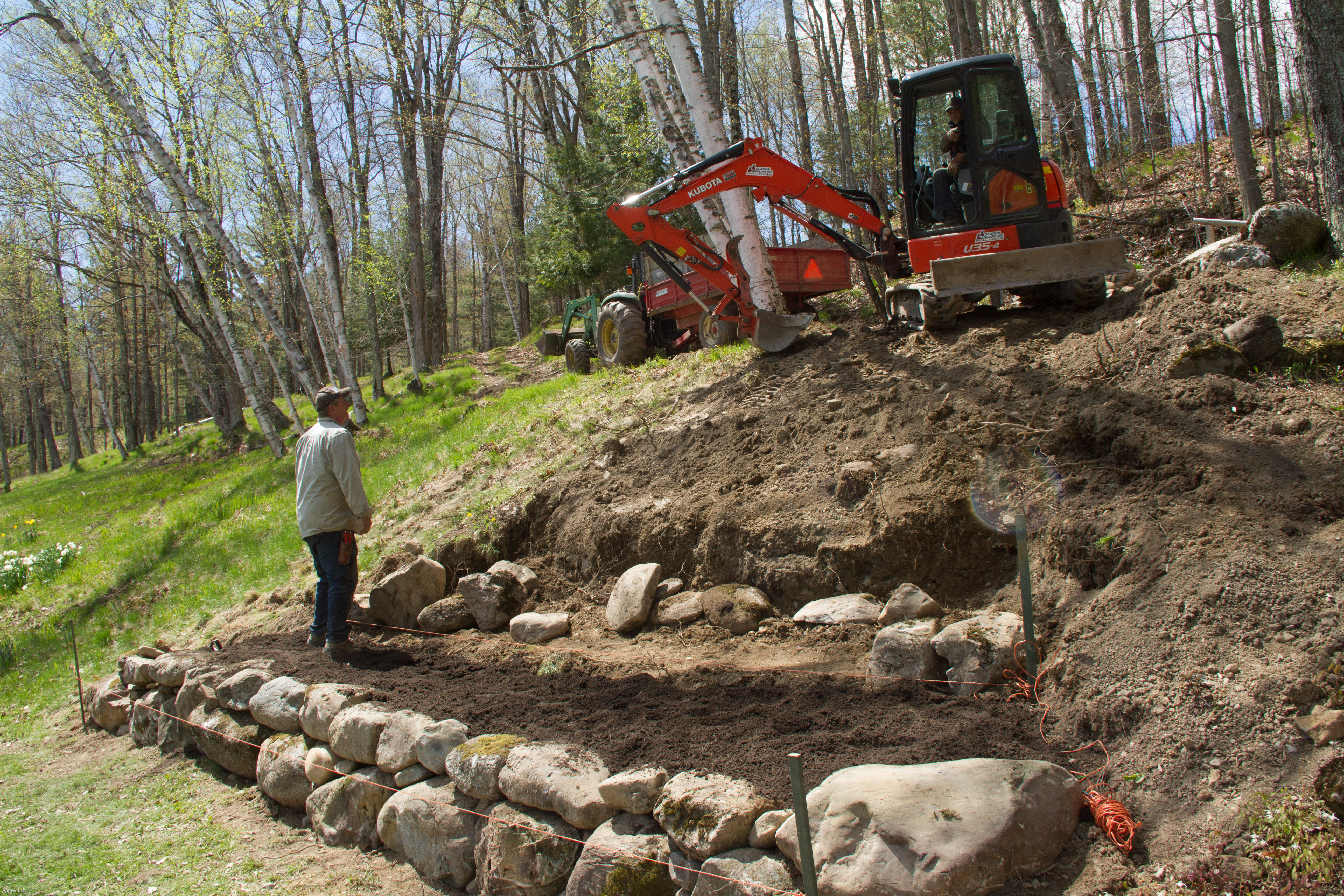
Early on in the project, I realized the walls had to be higher. That meant more rocks, and more time.
But the result is all I could hope for: three terraces, each three feet higher than the one below and each slightly shorter and each about six feet wide.
We started planting last week. We are re-using the shrubs that were there before: Weigela ‘Wine and Roses’ on the lowest terrace, a few Aralia ‘Sun King’ on the second, and Persicaria polymorpha, or giant foamflower, on the third. At the very top where it is almost full shade, we planted ferns dug from the woods and spotted some indigenous thalictrum around the rocks. Finally we rescued some rooted bits of Stephanandra from the Lower Garden and planted them along the side slopes where they should tumble nicely.
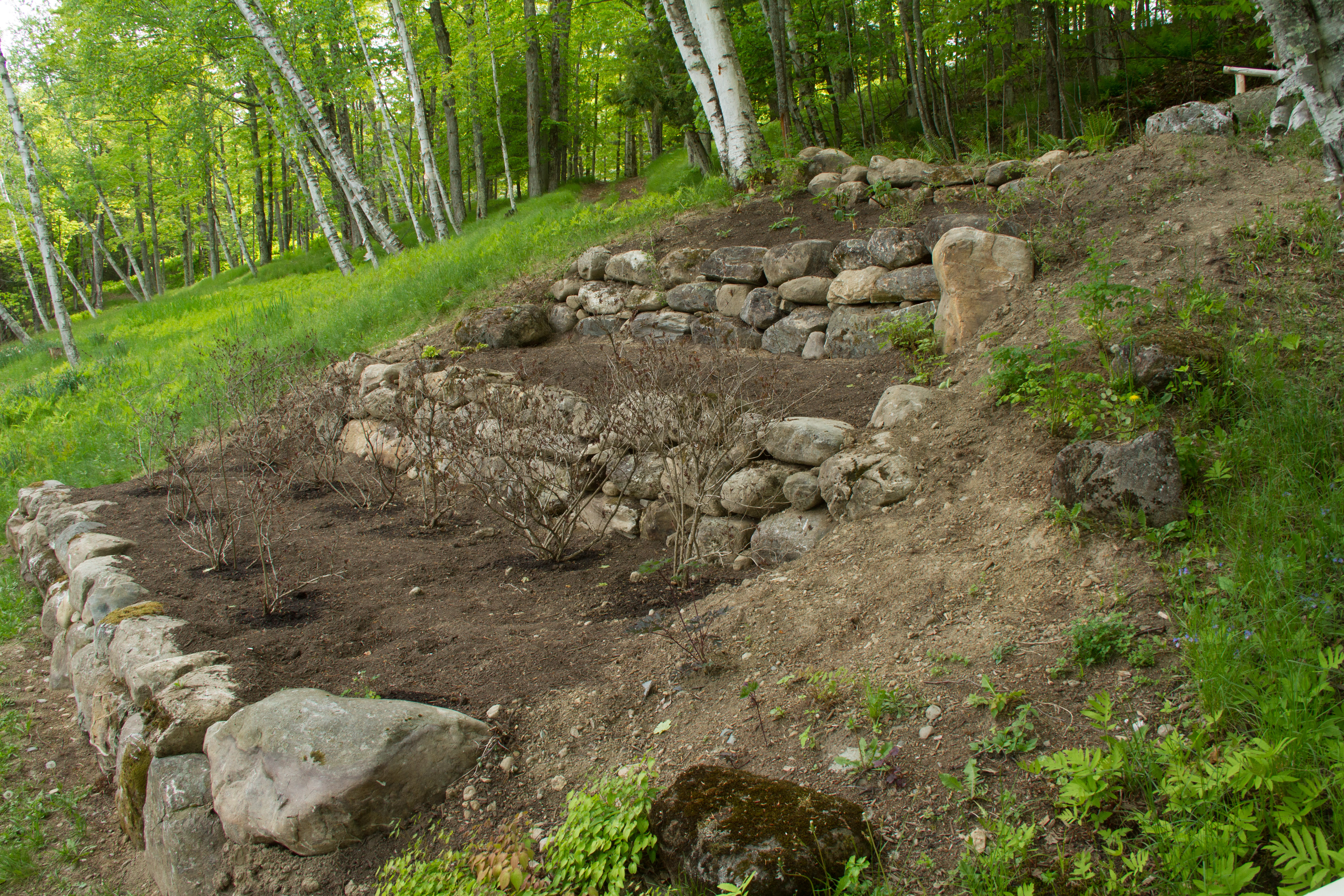
The weigela look pathetic but they are beginning to leaf out.
So far I haven’t bought any new plants but since the area is larger than before, I will have to. New plants will include some low growing ground covers under the Weigela, one of which should spill over the rocks in front. I may spot some perennials here and there — epimediums are growing well in one section so I’ll probably add more. I want to keep the plantings simple, though, so I don’t intend to use too many different types of plants.
The question that remains is what to plant on the second, or middle, terrace. I could plant more Aralia but that seems boring, as does spirea. The wispy plumes of Filipendula would be nice but the deer like them, and choosing a shrub that is deer-resistent is a must. I want the shrub to have light-coloured leaves so that the dark-leafed weigela stands out against it. The plant needs to be tall — around 5-7 feet would be fine. Ideally it would be a ‘country’ shrub that people used in the 1900s, but this is less important than finding one that will grow well in an area with soil that tends to be dry and that gets just under six hours of sunlight.
Suggestions, anyone?







As museologist in a previous life, I’m very joyful to see how you recall creatively and intelligently memory of the past. Thanks to do that.
Thank you, Vincent. Making that connection between past and present is very important to me.
Very interesting to see the evolution of the staircase. Looking forward to seeing the terrace’s new terrace!
The bed has also evolved but is looking so horrible at the moment that I couldn’t bear showing it.
I love to hear of your thinking and doing and struggling – with things which seem so very like our struggles and unlike any I come across elsewhere. Then you end with a plant question and I can only say that I so often have to wait and see, wait and think before I can make my own choices never mind yours!
It all takes so long. We just bought 2 clematis because we saw that the ones we have now are making a half wall of a display and we could maybe make it a whole wall, all along the edge of the wood. But will we live long enough to see it?? It’s a very hard and odd thing we do, isn’t it? Keep at it! Xxxx
All those nice old field stone rocks just lying around to make a beautiful terraces and already tailored!
The garden of my dreams is a woodland garden, Pat, and I’d happily move into yours – woodland environments aren’t at all common in coastal Southern California. I’m envious of your newly terraced area as that’s something I’ve wanted to do on my neglected back slope. Unfortunately, getting heavy equipment down there would be nearly impossible so a lot of manual labor would be required. Our climate and conditions are so different that I couldn’t begin to make suggestions on plants, although a weeping Japanese maple comes to mind.
What a difference there is in our situations and growing conditions! Japanese maples barely survive here, so while I agree that one could look stunning, it isn’t going to happen!
Our woods are genuinely woods — or forests. We look after them but rarely, if ever, intervene. And I sympathize with the difficulties of getting heavy equipment into certain areas. I’d love to do some ground levelling in one part of the garden but getting equipment there would make much too much mess. So, like you, I live with the possible and enjoy what I can do rather than become depressed about what I can’t.
Is anyone having trouble commenting on this post or others? I received an email from a reader suggesting there are problems. Please let me know if there are — you can send an email directly to [email protected]
Huge improvement! I love that mossy bed. As for plants, how about some Aruncus/Goatsbeard? Oakleaf Hydrangea?
I love Aruncus and had it there. The deer appreciated it, too. As for Oakleaf Hydrangea, I’d give a lot to be able to grow it but even in a very sheltered spot, it shivered and died.
Another thought – mix some native American Spikenard with the exotic Aralia?
That’s a thought. It might be too short. I’m looking into some of the native Viburnums, or possibly a new cultivar called Red Balloons which looks promising.
Keep the ideas coming!
It looks fantastic, Pat!
Thanks, Kathy. Once the plants are all in place and begin to grow, I’ll be happy.